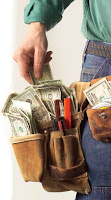Pending Home Sales Continue Recovery,
Gradual Improvement Seen in 2011
Washington, DC, December 30, 2010 - Pending home sales rose again in November, with the broad trend over the past five months indicating a gradual recovery into 2011, according to the National Association of Realtors®. The Pending Home Sales Index,* a forward-looking indicator, rose 3.5 percent to 92.2 based on contracts signed in November from a downwardly revised 89.1 in October. The index is 5.0 percent below a reading of 97.0 in November 2009. The data reflects contracts and not closings, which normally occur with a lag time of one or two months.
The Pending Home Sales Index,* a forward-looking indicator, rose 3.5 percent to 92.2 based on contracts signed in November from a downwardly revised 89.1 in October. The index is 5.0 percent below a reading of 97.0 in November 2009. The data reflects contracts and not closings, which normally occur with a lag time of one or two months.Lawrence Yun, NAR chief economist, said historically high housing affordability is boosting sales activity. “In addition to exceptional affordability conditions, steady improvements in the economy are helping bring buyers into the market,” he said. “But further gains are needed to reach normal levels of sales activity.”
The PHSI in the Northeast increased 1.8 percent to 72.6 in November but is 6.2 percent below November 2009. In the Midwest the index declined 4.2 percent in November to 78.3 and is 7.7 percent below a year ago. Pending home sales in the South slipped 1.8 percent to an index of 91.4 and are 7.2 percent below November 2009. In the West the index jumped 18.2 percent to 123.3 and is 0.4 percent above a year ago.
“If we add 2 million jobs as expected in 2011, and mortgage rates rise only moderately, we should see existing-home sales rise to a higher, sustainable volume,” Yun said. “Credit remains tight, but if lenders return to more normal, safe underwriting standards for creditworthy buyers, there would be a bigger boost to the housing market and spillover benefits for the broader economy.”
The 30-year fixed-rate mortgage is forecast to rise gradually to 5.3 percent around the end of 2011; at the same time, unemployment should drop to 9.2 percent.
 For perspective, Yun said that the U.S. has added 27 million people over the past 10 years. “However, the number of jobs is roughly the same as it was in 2000 when existing-home sales totaled 5.2 million, which appears to be a sustainable figure given the current level of employment,” he explained.
For perspective, Yun said that the U.S. has added 27 million people over the past 10 years. “However, the number of jobs is roughly the same as it was in 2000 when existing-home sales totaled 5.2 million, which appears to be a sustainable figure given the current level of employment,” he explained.“All the indicator trends are pointing to a gradual housing recovery,” Yun said. “Home price prospects will vary depending largely upon local job market conditions. The national median home price, however, is expected to remain stable even with a continuing flow of distressed properties coming onto the market, as long as there is a steady demand of financially healthy home buyers.”
Existing-home sales are projected to rise about 8 percent to 5.2 million in 2011 from 4.8 million in 2010, with an additional gain of 4 percent in 2012. The median existing-home price could rise 0.6 percent to $173,700 in 2011 from $172,700 in 2010, which was essentially unchanged from 2009.
“As we gradually work off the excess housing inventory, supply levels will eventually come more in-line with historic averages, and could allow home prices to rise modestly in the range of 2 to 3 percent in 2012,” Yun said.
New-home sales are estimated to rise 24 percent to 392,000 in 2011, but would remain well below historic averages, while housing starts are forecast to rise 21 percent to 716,000.
Yun sees Gross Domestic Product growing 2.5 percent in 2011, and the Consumer Price Index rising 2.3 percent.
The National Association of Realtors®, “The Voice for Real Estate,” is America’s largest trade association, representing 1.1 million members involved in all aspects of the residential and commercial real estate industries.
From: www.realtor.org




